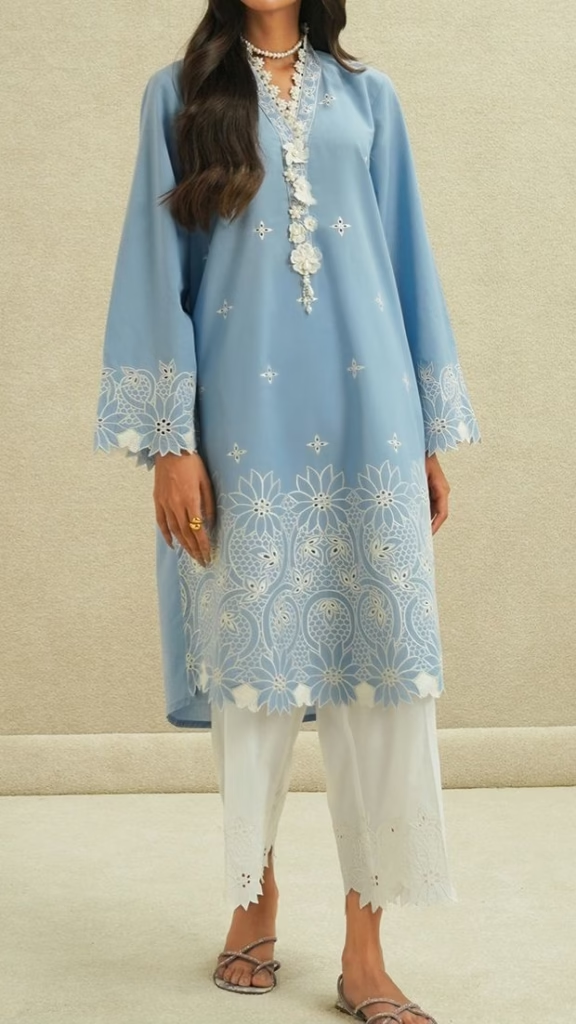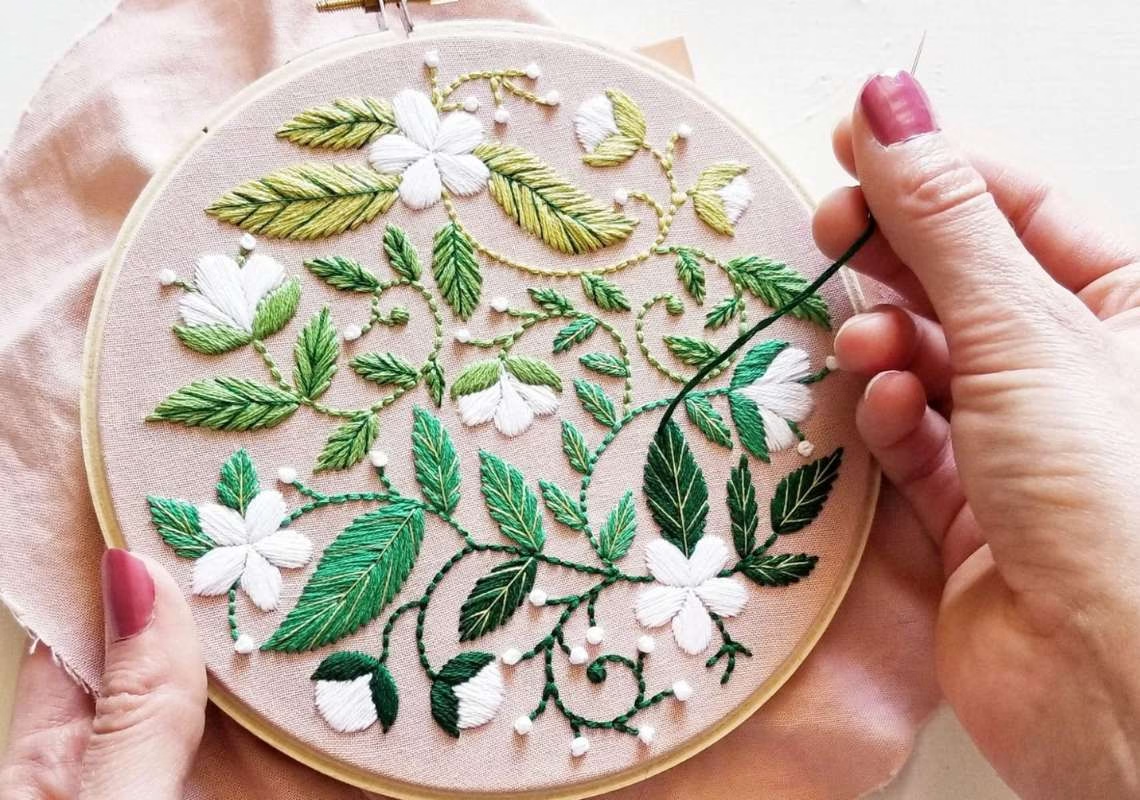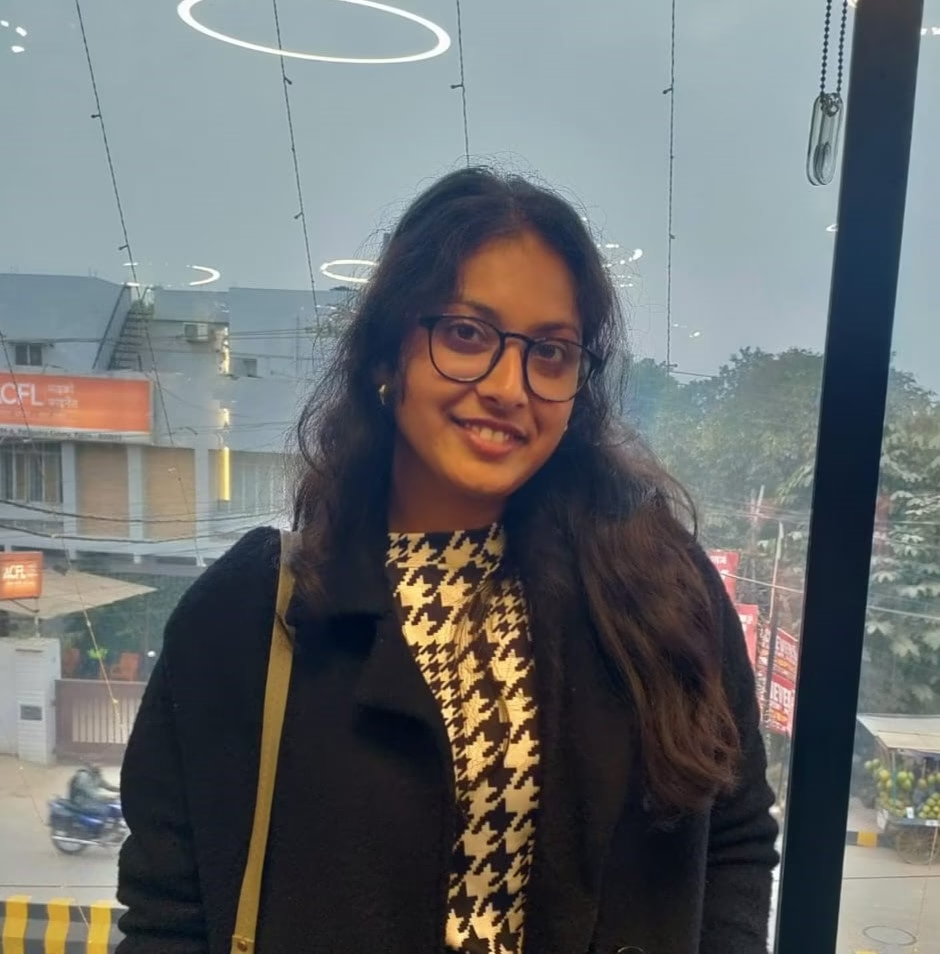Introduction: A timeless tradition of Chikankari Embroidery
When one talks about Lucknow’s beauty and tradition, the first thing that comes to mind is the art of hand embroidery, called’ Chikankari’. The craft that indulges in intricate craftsmanship, delicate stitches and softest fabrics is the epitome of elegant and cultural richness. Chikankari art is not just a hand-embroidery craft but a poetic expression of elegance and fashion.
For someone who is fascinated by the Indian heritage craft, knowing about Chikankari is like stepping into a rich tapestry of culture, pride, and history. The magical appearance of chikankari embroidery is it is a combination of artistry and dedication that makes each piece unique. Whether it’s a stitched kurta or an ornate saree, chikankari embroidery is popular among the wardrobes of all fashion enthusiasts and designers, that embodies sophistication, and simplicity.
What is chikankari?

Chikankari is a traditional craft, derived from the Persian word ‘chikan’ which means ’embroidery’. It is a hand-embroidery technique that includes making intricate patterns on high-quality and soft fabrics like cotton, muslin and silk. The art of Chikankari, known for its understated elegance, has the power to transform simple garments into the finest masterpieces, combining delicate floral and geometrical motifs with a finesse unmatched by any other embroidery style.
Lucknow’s textile art is a delicate form of embroidery design and pattern that are stitched on fabric through a needlework art that requires great skills and effort. The art shows the patience and artistic handwork of the artisans that make the simple fabrics look beautiful with different and unique designs like kneel, Bakhiya, Jaali, and Kangan.
A History: A Legacy of hand-embroidery
The history of this timeless art is as enchanting as the art form itself. The story behind this art form captures the richness of the culture and tradition.
Origins in Mughal grandeur:
Chikankari is believed to have originated in the Mughal era, dating back over 400 years. The story has it that Noor Jahan, the wife of Emperor Jehangir, was an art lover and she was the one who introduced this art form to India, the art inspired by the Persian tradition of embroidery. However, some historians believe that the art form has older connections and roots before the Mughal era. They believed that the craft has a reference to some similar techniques in ancient text like Mahabharata.

Flourishing under the Nawabs
ChikanKari art flourished as an aristocratic craft during the Mughal era adorning royal robes and courtly attires. Lucknow due to its rich cultural tapestry, became the epicenter of this art form where this hand-made embroidery set its legacy. In this alluring craft, the artisans combine the Persian influence with Indian emotions and sensibilities, adding a unique touch by creating special motifs inspired by flora and fauna. Then the Nawabs of Awadh nurtured chikankari embroidery, ensuring that this remains an integral part of Lucknow’s pride and unique identity.
In the 18th and 19th centuries, the Nawabs, the rulers at that time, played a vital role in elevating the chikankari embroidery, who valued and cherished it as a treasured part of the city’s culture. Although this hand embroidery faced many challenges during British rule, the effort and dedication of artisans kept the art alive, who understood its cultural importance. Today, this art form is a symbol of India’s textile heritage known for its intricate craftsmanship and timeless appeal. It gained immense popularity in the whole world.
This art form got geographical indication (GI) status in 2008, which embraces and protects its origin and appealing characteristics. The GI status ensures that only the original handmade embroidery produced in the designated geographical region can be labelled, preventing imitations by machine-made fabrics and maintaining authenticity.
Remarkable Elegancy: What makes chikankari unique?
Lucknow’s Chikankari is recognized for its meticulous designs and artwork.
The craftmanship
It takes a different level of artistry and hard work to create chikankari embroidery. The artists use a variety of needlework and stitches such as ‘Jaali’ (openwork) that adds delicate mesh-like charm to fabrics, ‘Bhakiya’ (shadow-work), that showcases shadow stitching beauty, and ‘Phanda'(knot-work) that adds a charm of knot-like details in the artwork. These detailing are done to give intricate designs that look ethereal and stunning. Each piece of stitches is a testament to the artist’s patience, skill and effort.
The motifs
The designs are inspired by florals such as rose, jasmine, and lotus that reflect the Mughal aesthetics focusing on flower patterns. Geometric designs and paisleys are used in the embroidery, often arranged in a harmonious composition to enhance the elegance of the fabrics.
The fabris
The fabrics of any textile art form serve as the canvas, capable of elevating any design. Chikankari embroidery is done on high-quality lightweight fabrics such as muslin, cotton and mulmul, which always the hand embroidery shine. In modern fashion the artwork is also done on fabrics like silk, Georgette and chiffon, appealing to contemporary tastes.
The process behind the Lucknow’s Elegant Hand Embroidery
The process of chikankari takes patience, artistry and precision to create every stitch the masterpieces.
Designing: The first step includes designing the patterns that are created on the paper and then block printed onto a fabric. The prints are done with washable ink. These designs serve as a guide for needlework embroidery.
Stitching: The artisans start to make the embroidery stitch-by-stitch using a fine needle and cotton thread. It takes over a week or a month to complete the designs, depending on the complexity of the designs. Each stitch adds depth and texture that represent the artistic skill of craftsmanship.
Washing: After the embroidery is done, the fabrics are washed on Dhobi-Ghaat to remove ink traces and any residual dyes, leaving only the beautiful handwork behind.
Final Touch: Then the fabric is given the final touch, it gets ironed, inspected for quality and finally prepared for garment use or any other textile products.
The Role of women in chikankari

Historically, the chikankari art has provided employment to many women in urban and rural areas. It is an opportunity for empowerment and livelihood. Women performing this craft usually come from those areas where the source of income is limited. By engaging in this hand-made embroidery, these women achieved financial independence. Their reasons and interests become contributions towards the prevention of centuries-old traditions.
Along with the economic aspect, Chikankari has brought a sense of pride and identity among women artisans. It brings them together in a collective effort to celebrate the country’s heritage while creating something so beautiful and appealing. Many women have supported, maintaining the cultural identity of chikankari by passing down this timeless craft to the younger generation, ensuring that chikanKari embroidery remains the heart of Lucknow’s fashion trend.
Challenges faced by the artisans
Despite its global recognition, Chikankari art form faced many challenges. One of the toughest challenges is the rise of machine-made designs that imitate chikankari embroidery. These are cheap alternatives that flood the market, making it difficult for traditional artists to compete. The authenticity is getting lost. The lack of intellectual property and proper recognition makes the problem worse.
Another significant challenge faced by artisans is a lower fair wage. Many artisans especially, women artisans are underpaid despite their immense skills and time required to create such pieces. This disparity often discourages young generations from taking up the crafts, questioning their livelihood.
Another problem faced by them is limited access to the global market. While chikankari art form reaches the international market, artisans have to depend on middlemen which reduces their income. It is important to address these issues and collectively put effort into supporting the cultural heritage through government support, fair trade incentives, and consumer awareness about buying the original authentic handmade product
Global recognition: Bridging tradition and trend
Chikankari has transcended its traditional boundaries and made a pace in a contemporary fashion. Many designers like Manish Malhotra, Abi-Jani and Sandeep Khosla have embraced this embroidery in their collections blending traditional heritage with modern fashion.
From the red carpet to the runway and in New York’s boutiques, chikankari art is admired all around the world. Lucknow’s chikankari is also incorporated into bohemian and minimalistic aesthetics where the traditional delicacy blends with simple silhouettes. In the Middle East, chikankari is embraced for its intricate designs in the form of kaftans and abayas.
The future of chikankari art form in modern fashion looks promising. Fashion brands are collaborating with Indian artisans to create exclusive collections, bringing this beautiful art form to a broader audience. This cross-cultural exchange of tradition and fashion highlights global appeal and also ensures the preservation and engagement of future generations.
Why should you own Lucknow’s hand-embroidery? A symbol of style and sustainability
A style that embraces elegance, perfection and the journey of its ethnic history is an ideal choice for your wardrobe. That is ‘chikan embroidery‘. By investing in authentic chikankari, you are not only acquiring rich-quality fabrics but also supporting the empowerment and livelihood of deserved artisans. It’s a combination of the cultural richness and artistic genius of India.

In this fast-fashion world, chikankari embodies the spirit of slow fashion. Unlike the mass production of machine-made garments, each piece is created with love and care, making it special. It also promotes sustainability because the process of creating each piece is eco-friendly while adding the element of style and grace. Chikankari’s versatility makes it perfect to style on any occasion whether it’s a casual outing or a grand celebration.
How to style a chikankari in today’s fashion
Today’s fashion is all about innovation and feeling good on your skin. Chikankari’s designs are all innovative ideas and patterns of artisans. The fabrics of this embroidery feel comfortable and breathable on the skin.
Everyday elegance: One can style a chic yet comfortable look by pairing up a chikankari Kurti or top with jeans and palazzos. Add accessories like oxidized Jhumki and bangles to give an Indo-western look with a touch of traditional glamour.
Festive flair: More people are opting for chikankari sarees or lehngas, adorned with mukaish or sequins in weddings or other festival occasions. It’s a best choice for farewell sarees. The subtle sophistication is sure to turn heads.
Office/casual ready: A combination of a chikankari embroidery top or shirt with straight fit pants or tailored trousers exudes professionalism while keeping your style game strong.
Tips to identify a pure Chikankari
Identifying a pure chikankari is important for consumer awareness and it is done by knowing the difference between hand-made and machine-made embroidery. There are few ways once can consider finding out the real one:
Always look at the inner reverse side of chikankari fabric, the handmade embroidery with its intricate pattern always has a lose threads and knot, as it is hand-stitched while machine embroidery will have cleaner and polished design showing perfection yet imitation. Hand-stitched will have intricate patterns that adds a natural charm with rich look. Machine-made lacks depth and looks too uniform.
The high-quality fabrics are expensive but a long-lasting investment for your wardrobe. The authentic chikankari is done on lightweight and breathable fabrics but if the material is stiff or synthetic them it might be not genuine. Also feel the texture of the embroidery because the pure ones have a raised and textured feel while the fake ones are flattered.
It is recommended to buy from genuine sources, or directly from artisans or certified sellers to ensure you’re getting the pure chikankari. Supporting to prevent this timeless beauty is our right!
Conclusion: A craft close to the heart
I can remember the chikankari craft in my kurta, each stitch piece, delivering a story of dedication, artistry, resilience and tradition. Whether you’re a fashion enthusiast or someone interested in Indian heritage and textile craft, chikankari embroidery is a unique option giving a touch of elegance. The art form, originated from ancient times has stood the test of time, connecting people and generations through its beauty and authenticity.
In today’s fashion industry chikankari is not only limited to women’s outfits, but even men’s collections are also getting the appraisal, especially in weddings. Chikankari fabrics are so appealing that they stand out amongst other types of fabrics in the market, catching everyone’s attention.
This hand-made embroidery is not just about style but a celebration of those hands that create this artistic pattern and cultural significance. So, next time when you buy a chikankari, try to appreciate the mastery of innovation and the journey of craftsmanship. It is more than a fashion; it’s a stitching history woven with love and care.
For further reading on significance of Chikankari, you can visit these useful resources:
Check out our Blog Page on Traditional Indian art.



Leave a Reply